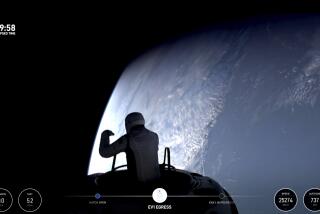Space Walkers Snag Satellite, Make Repairs
- Share via
HOUSTON — Using a lot of human elbow grease and a broken mechanical arm, two astronauts floating 225 miles above the Earth captured a disabled satellite Saturday and brought it next to their orbiting repair shop.
The space walkers’ task would have been a “piece of cake” if the Discovery’s robotic arm had worked right, said astronaut James D. van Hoften, but the device functioned so slowly and awkwardly that he and fellow astronaut William F. Fisher will have to finish the job today.
The astronauts set a new endurance record, remaining outside the Discovery for 7 hours, 8 minutes--longer than any other humans have spent orbiting the Earth outside a spaceship, according to statistics provided by the National Aeronautics and Space Administration. Their time was 29 minutes shorter than the longest space walk ever, but that took place on the surface of the moon by two Apollo astronauts in 1972.
During Saturday’s space walk, the Discovery astronauts traveled more than 124,000 miles, pausing only briefly to marvel at the Earth below.
The robotic arm, which gave them their only significant problem, had been damaged somehow during the first few hours of the flight. From his post inside the ship, John M. Lounge, 39, had to control each of its three joints individually rather than through a computer-assisted system.
The 6-foot, 4-inch van Hoften, known as “Ox” to his colleagues, rode the tip of the mechanical arm out to the satellite, attached a temporary handle to its side and handed it to Fisher, whose feet were locked on the side of the shuttle’s cargo bay.
“It’s kind of a beast, isn’t it?” Fisher asked as he held the 15,200-pound satellite over his head while traveling around the Earth at 17,500 m.p.h. Although the satellite weighs nothing in space, its mass gave both astronauts all they could handle. Fisher has been lifting weights for the last three months to build up his strength for what appeared to be a Herculean feat, holding the satellite aloft with one hand while controlling its swing with the other.
Electronic Boxes Attached
By the end of the marathon space walk, Fisher, a surgeon, had completed two mechanical “bypass” operations on the satellite, hooking up electronic boxes that will allow ground controllers to take over later today and activate it. The satellite’s main rocket will not be fired for about two months, however, so that propellants exposed to the cold of space can be unfrozen in an effort to reduce the chances that the satellite will explode upon ignition.
Today, the astronauts will undo much of what they accomplished Saturday by removing a series of safety controls they installed to prevent the satellite from accidentally firing its rockets while the shuttle was alongside. Then Van Hoften will manually spin the satellite up to about two revolutions per minute to give it stability, leaving the rest to fate.
Discovery commander Joe Engle, 53, and pilot Richard O. Covey, 39, had maneuvered the shuttle several times in the last few days to bring it alongside the satellite, called Leasat 3 and owned by Hughes Communications of El Segundo, Calif. Hughes paid NASA about $8 million for the rescue attempt in hopes of saving the $85-million mechanism.
‘Looks Brand New’
Although the satellite has been drifting lifelessly in orbit since it failed to activate itself last April, Fisher reported that “it looks brand new.” It apparently was not damaged significantly by either its errant sojourn through space or an imaginative attempt to start it last April by Discovery crew members who built fly-swatter-type devices to try to snag a switch on its side.
They were successful in catching the switch, but that turned out not to be the problem. That effort apparently was the cause of a deep scratch Fisher saw along the side of the barrel-shaped satellite, but the scratch was not considered important.
Fisher found one other remnant from that operation.
“I found a piece of gray tape from the fly-swatter mission,” he told Mission Control in Houston. “I’ll bring it back for them as a souvenir.”
“How did they get it to stick, Fish?” astronaut George Nelson at Mission Control asked, alluding to the difficulty that the crew had in April making the tape work on their crude fly swatters.
“I don’t know,” Fisher replied. “It sure doesn’t stick anywhere else, does it?”
Screws Dropped
Fisher may be an outstanding surgeon, but he shares one flaw with most weekend mechanics. He dropped screws he removed from a panel on the side of the satellite.
Two of them “just floated away,” he said. The panel was not to be replaced, so the loss was insignificant.
Toward the end of the first day’s work, the astronauts got the first clue that their efforts would be rewarded. They threw a switch that activated one of the craft’s antennas.
“Hot dog, look at that, Jack,” Fisher said to no one in particular as the antenna snapped into place.
The shuttle is scheduled to land Tuesday at Edwards Air Force Base at 6:08 a.m.
More to Read
Sign up for Essential California
The most important California stories and recommendations in your inbox every morning.
You may occasionally receive promotional content from the Los Angeles Times.










